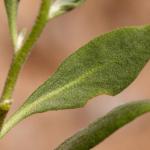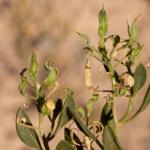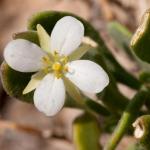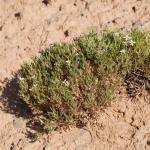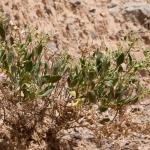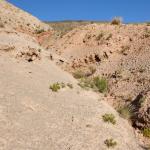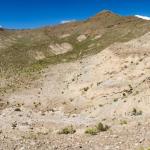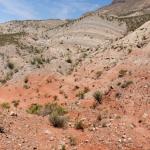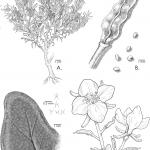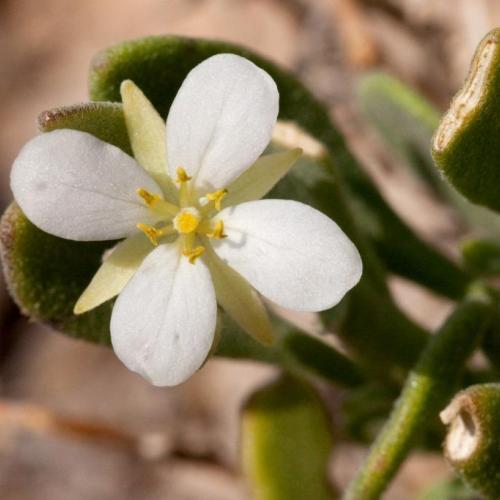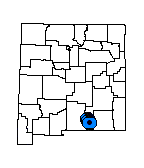Nerisyrenia hypercorax (Crow Flats Fanmustard)
Family
BRASSICACEAE
Synonyms
NONE
Common Name
Crow Flats Fanmustard
| USFWS | State of NM | USFS | BLM | Navajo Nation | State Rank | Global Rank | R-E-D Code | NMRPTC Status | Strategy Status |
|---|---|---|---|---|---|---|---|---|---|
| SEN | S1S2 | G1G2 | 3-1-3 | R | SS |
| Overall Conservation Status | Documented Threats | Actions Needed |
|---|---|---|
| WEAKLY CONSERVED | Livestock ranching/farming |
Avoid herbicide use in occupied habitat. |
Description
Dense, more or less hemispherical, perennial herb or sub-shrub from a branched, woody caudex, 1-3 dm high; stems and leaves pubescent with appressed, 3-rayed to dendritic trichomes; leaves alternate, succulent, (18-)22-40(-48) mm long, (4-)6-12(-14) mm wide, oblanceolate to spatulate, margins entire or, rarely, obscurely sinuate-dentate; inflorescences compact, ebracteate racemes (1.5-)2-4.5(-6.5) cm long, equaling or slightly exceeding the leaves; pedicels ascending to divaricate, (3-)4-9(-13) mm long; flowers white, conspicuous, 1-1.5 cm wide; sepals 4, green, pubescent, (3-)4-6 mm long, 1-1.5 mm wide, broadly lanceolate; petals 4, white and rarely fading to pale lavender, glabrous, 7-9 mm long, 3.5-4.5 mm wide, obovate to broadly spatulate, attenuate at the base; stamens weakly tetradynamous, 2.5-5.5 mm long, about equaling the sepals; carpels 2, connate, ovary tomentose, 2-4 mm long, style glabrous, 1.3-2.2 mm long; fruit an obcompressed (angustiseptate), oblong silique, crispate (tortulose) and usually incurved, 5-12(-16) mm long, 2.2-3 mm wide, with 20-40 seeds. Flowering late July to early September.
Similar Species
The crispate fruits of N. hypercorax are unique in the genus and allow this species to be easily distinguished from other Nerisyrenia in the area. Nerisyrenia linearifolia is frequent on gypsum in Otero and Chaves counties and, if fruits are not present, is distinguished from N. hypercorax by having linear leaves.
Distribution
New Mexico: Chaves County and Otero County, along the west base of the Guadalupe Mountains.
Habitat
Nerisyrenia hypercorax is a gypsophile, found only on sparsely vegetated exposures of gypseous clay of the Yeso Formation, from Pup Canyon north to 1.5 miles north of the Chaves / Otero county line along the west base of the Guadalupe Mountains. South of Pup Canyon, similar gypsum exposures have N. linearifolia rather than N. hypercorax. Extensions of this band of gypsum further north have not yet been surveyed. Frequent associated species include Haploësthes greggii, Thelesperma megapotamicum, Tiquilia hispidissima, Chamaesyce fendleri, Mentzelia humilis var. guadalupensis, Acleisanthes lanceolata, Oenothera hartwegii subsp. filifolia, Sporobolus nealleyi, and Chamaesaracha pallida. Within this habitat, N. hypercorax is usually most abundant in and along the edges of deeply-incised ravines.
Remarks
Nerisyrenia hypercorax is the third endemic gypsophile found along the west base of the Guadalupe Mountains thus far, after the discovery of Anulocaulis leiosolenus var. howardii and Mentzelia humilis var. guadalupensis in the late 1990’s. Although its habitat is very limited, N. hypercorax has been found in abundance at every site within this band of gypsum that has been visited.
Conservation Considerations
The area where N. hypercorax is found is remote and subject to very little disturbance other than cattle grazing. Gypsum in the area appears to be rarely visited by cattle, presumably due to the steep topography and low forage production associated with these outcrops. Applications of the herbicide tebuthiuron have been conducted adjacent to this band of gypsum to remove shrubs and, although the effects of this herbicide on N. hypercorax are not known, extension of these vegetation treatments onto gypsum would be a cause for concern.
Important Literature
Alexander, P.J., N.A. Douglas, H. Ochoterena, H. Flores-Olvera, and M.J. Moore. 2014. Recent findings on the gypsum flora of The Rim of the Guadalupe Mountains, New Mexico, U.S.A.: a new species of Nerisyrenia (Brassicaceae), a new state record, and an updated checklist. Journal of the Botanical Research Institute of Texas 8(2): 383-393.
Information Compiled By
Patrick Alexander 2015
For distribution maps and more information, visit Natural Heritage New Mexico

